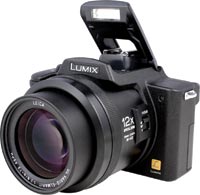Konica Minolta’s DiMAGE Z6 is almost identical in design to the Z3 and Z5 models but sports a higher-resolution, 6-megapixel sensor. The 12x optical zoom lens has the same specifications and focusing range and the control layout is identical, so the problems we identified with the SD card slot in the base of the Z3’s body remain unsolved in the Z6; it is still too easy to open inadvertently.










